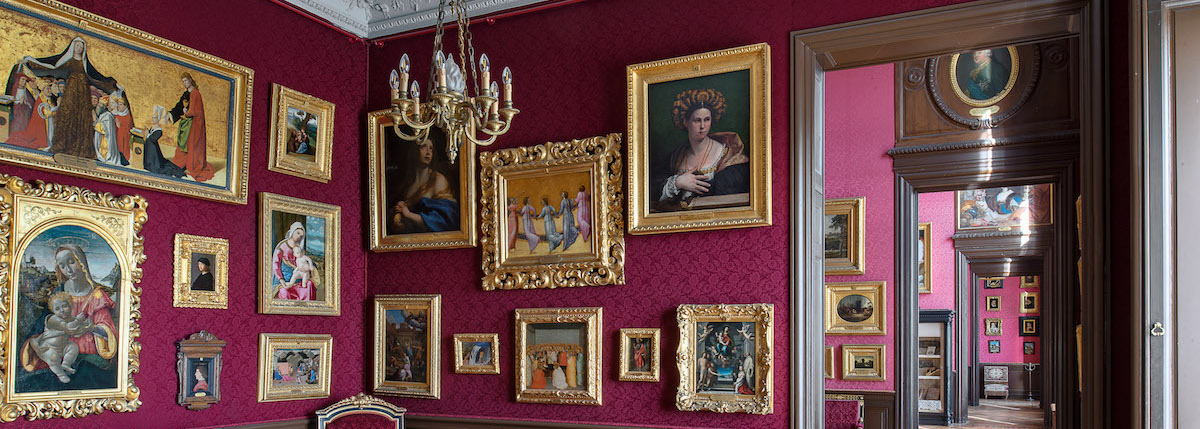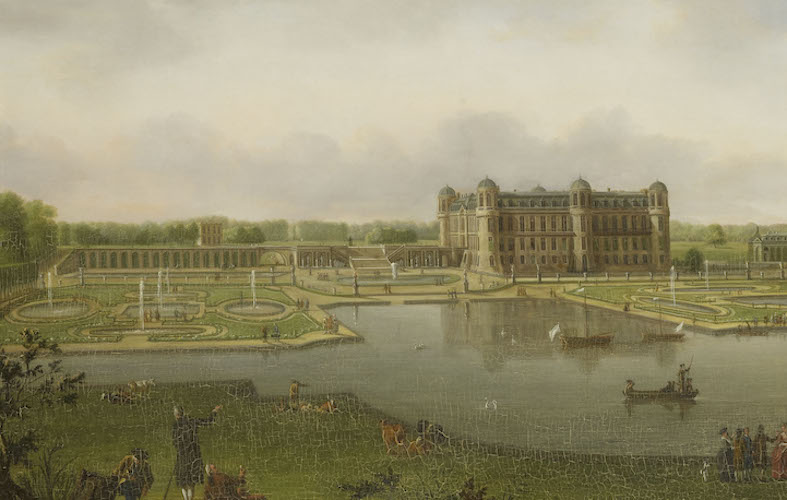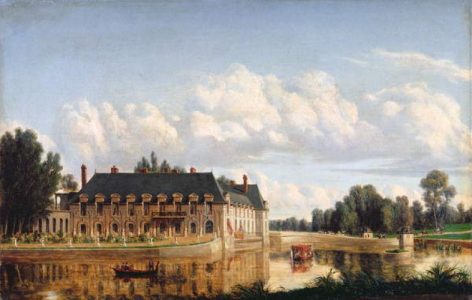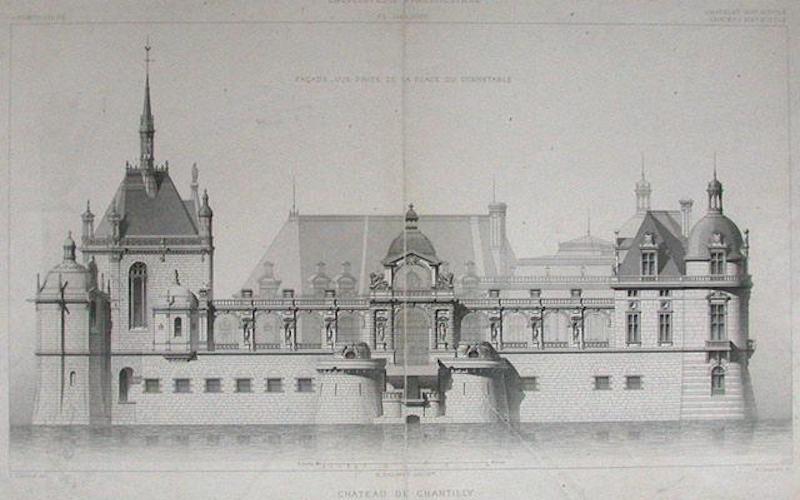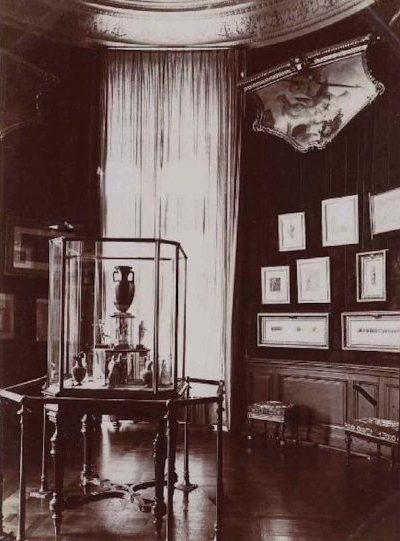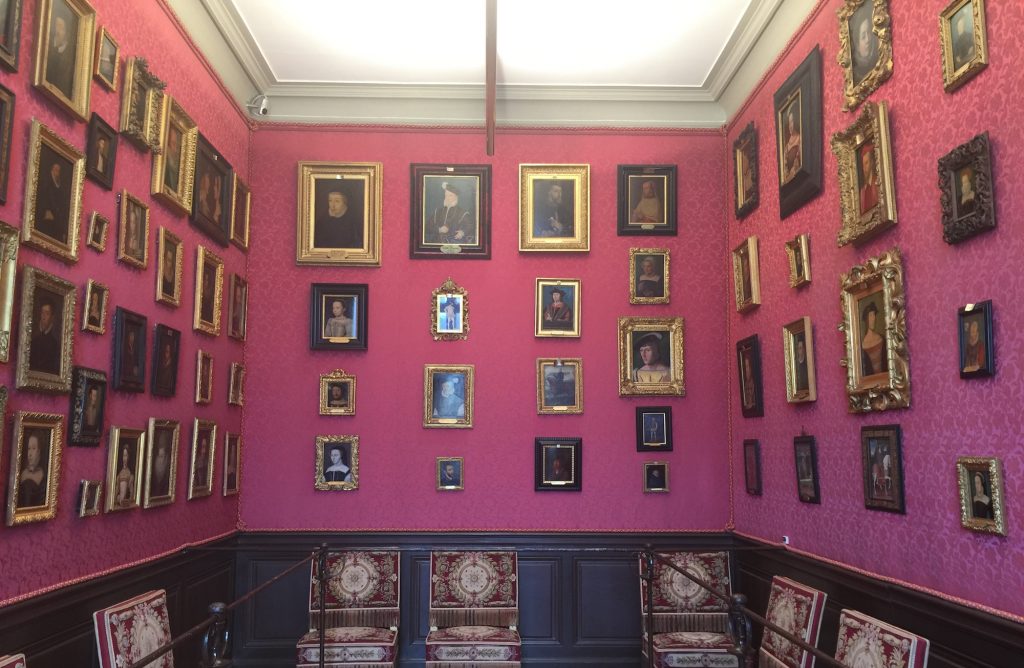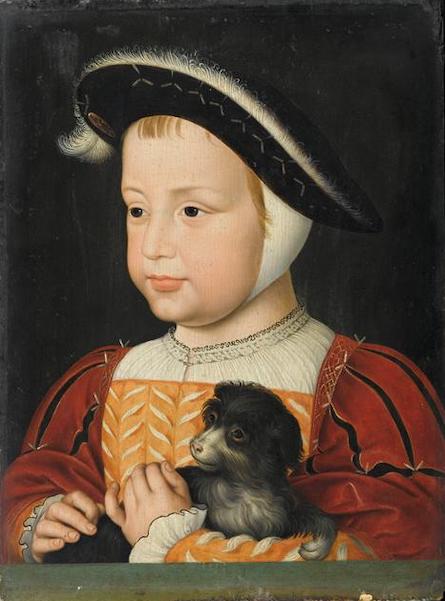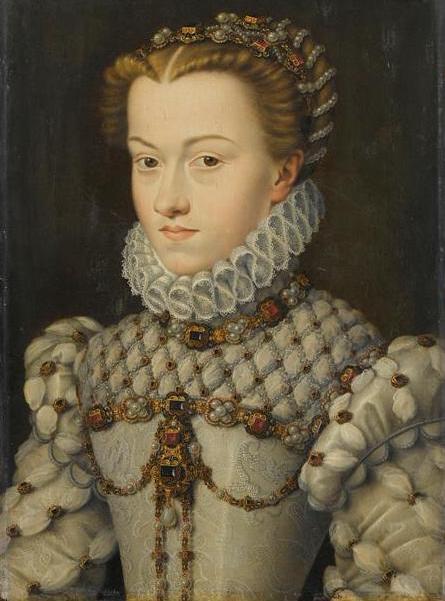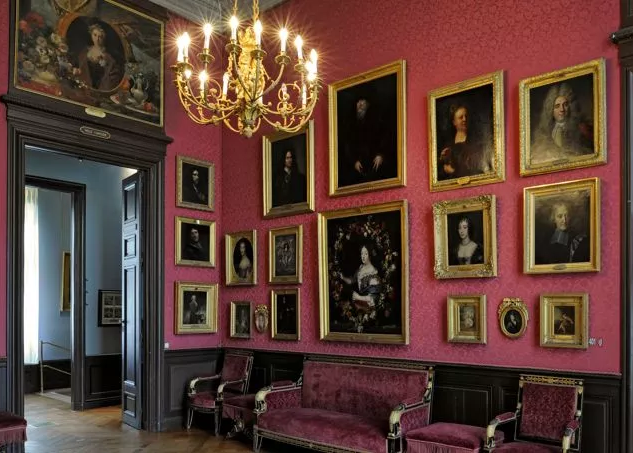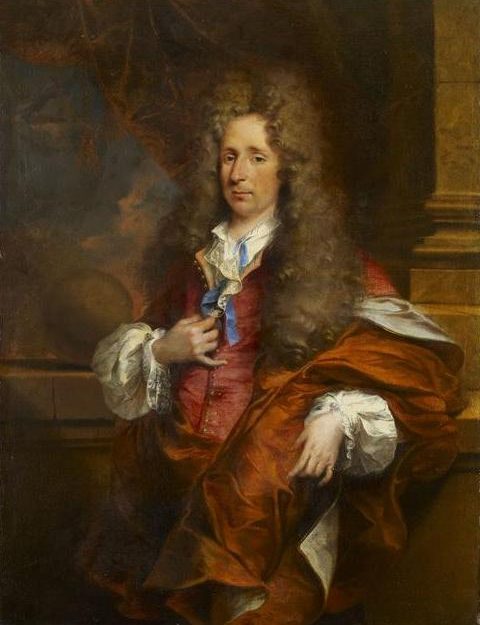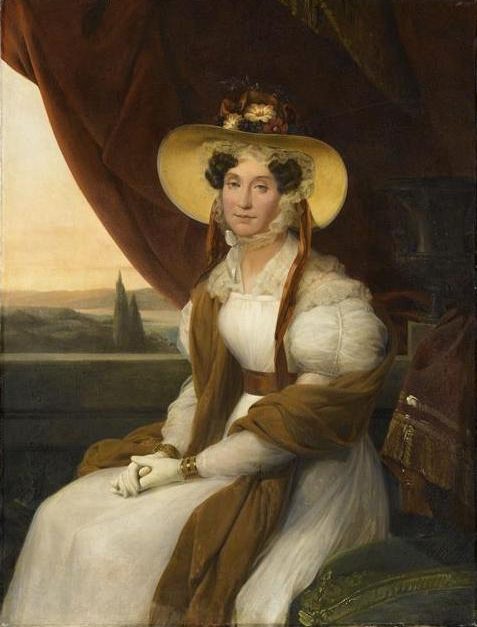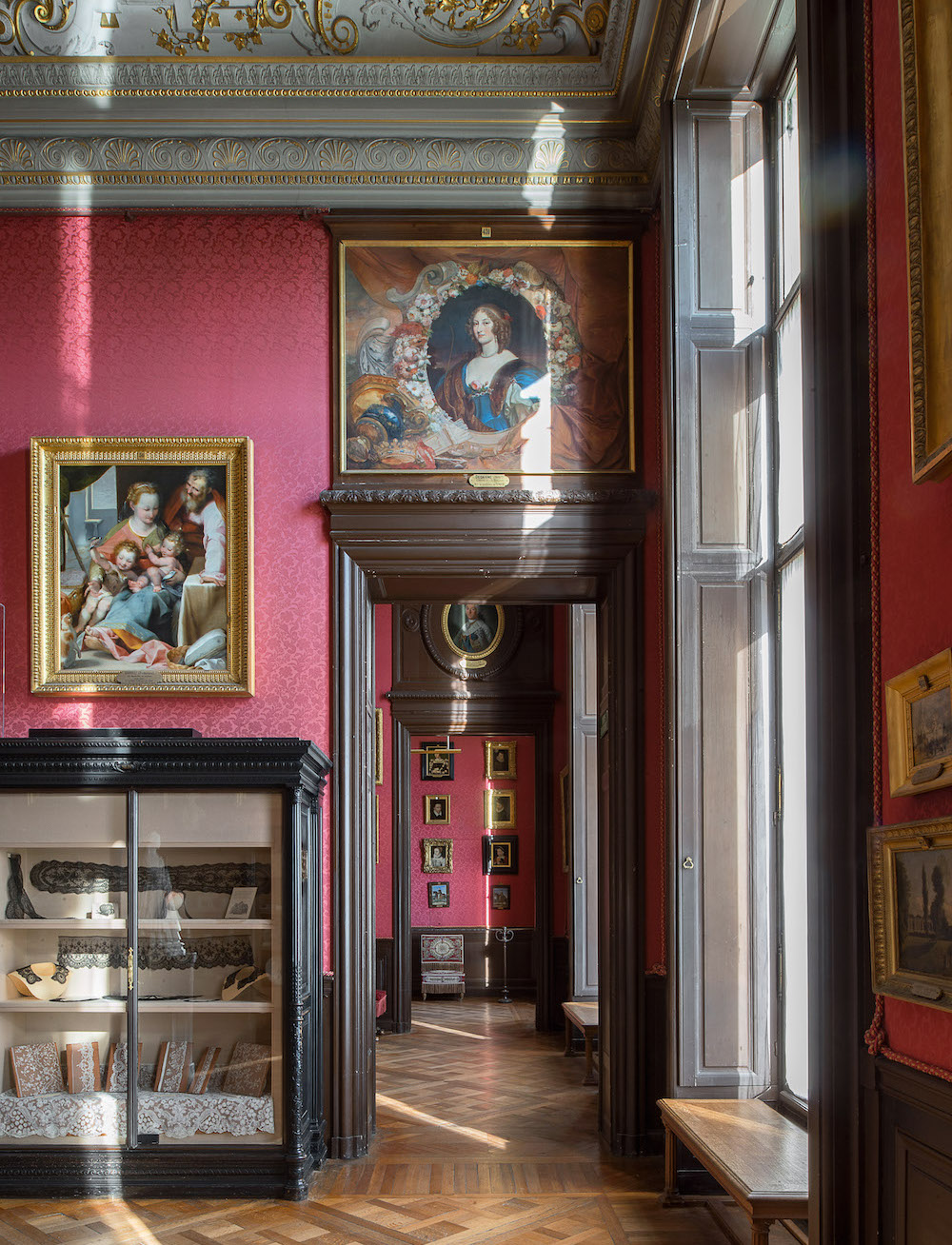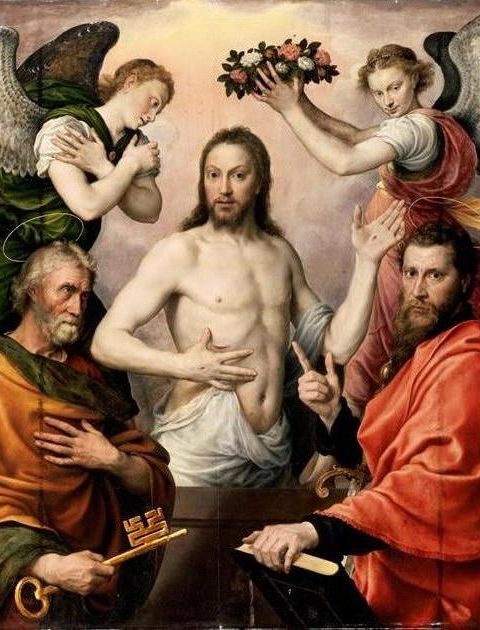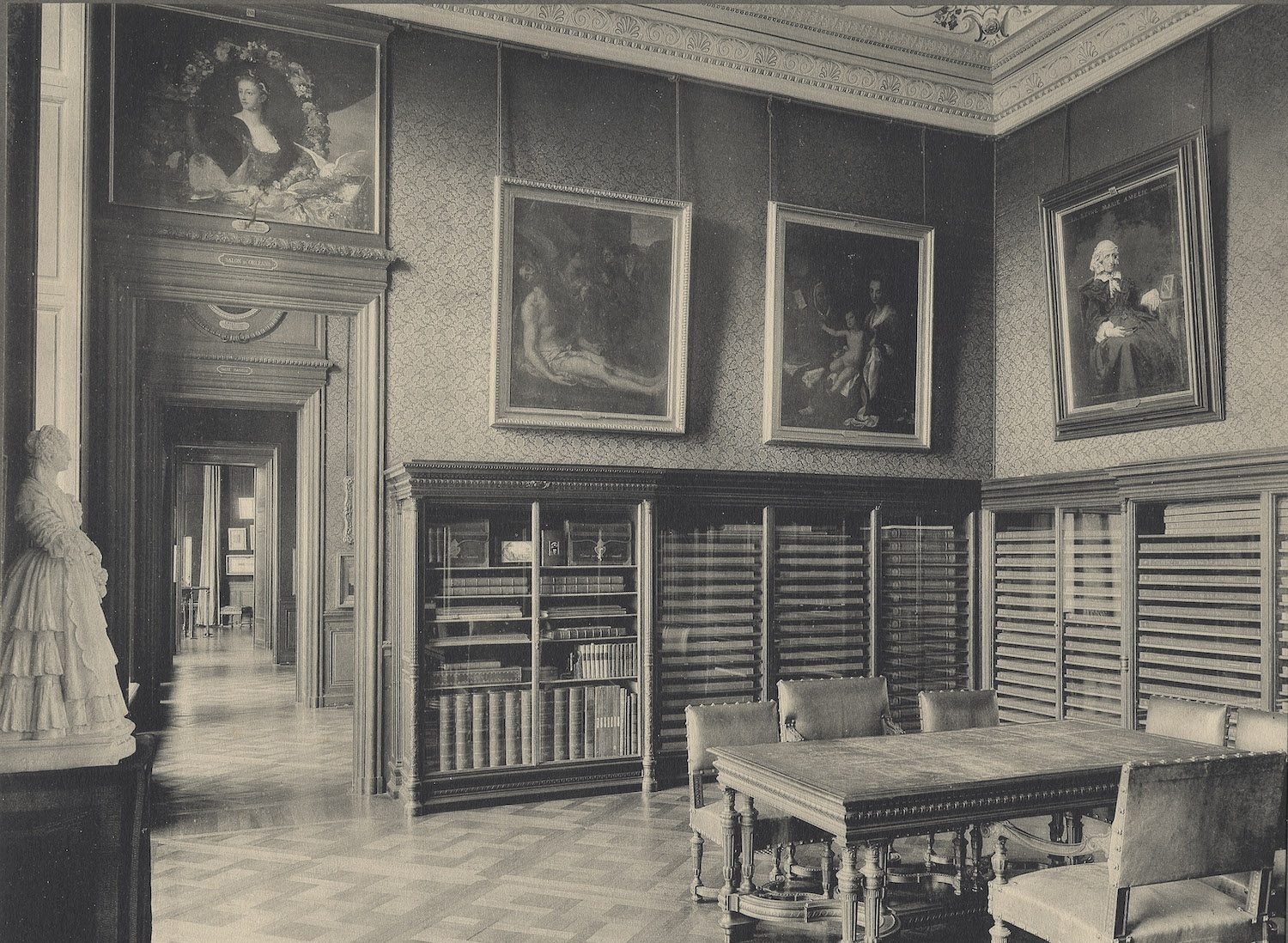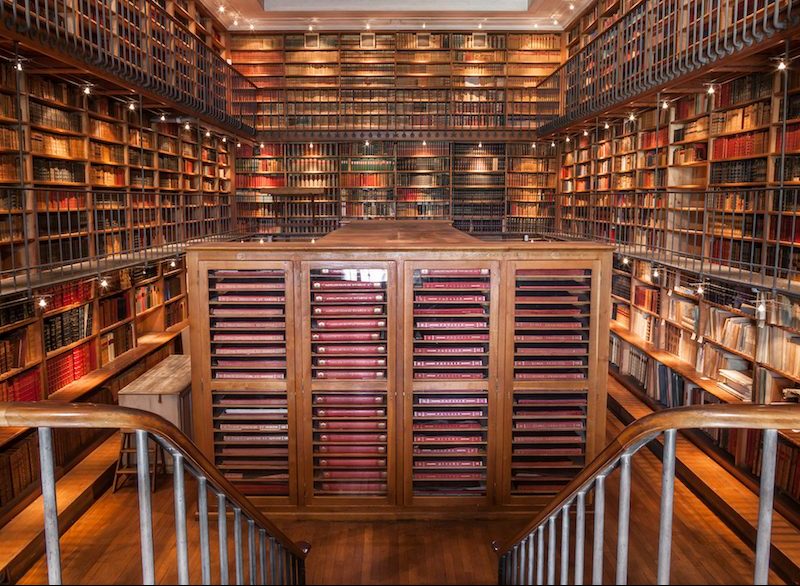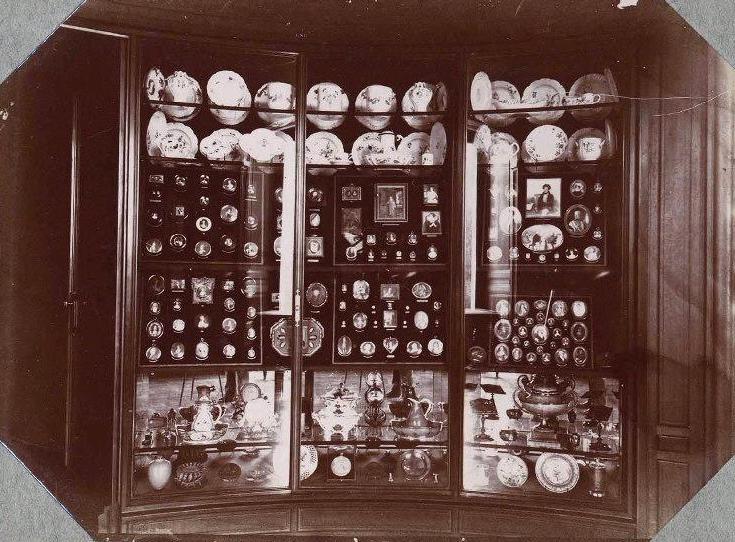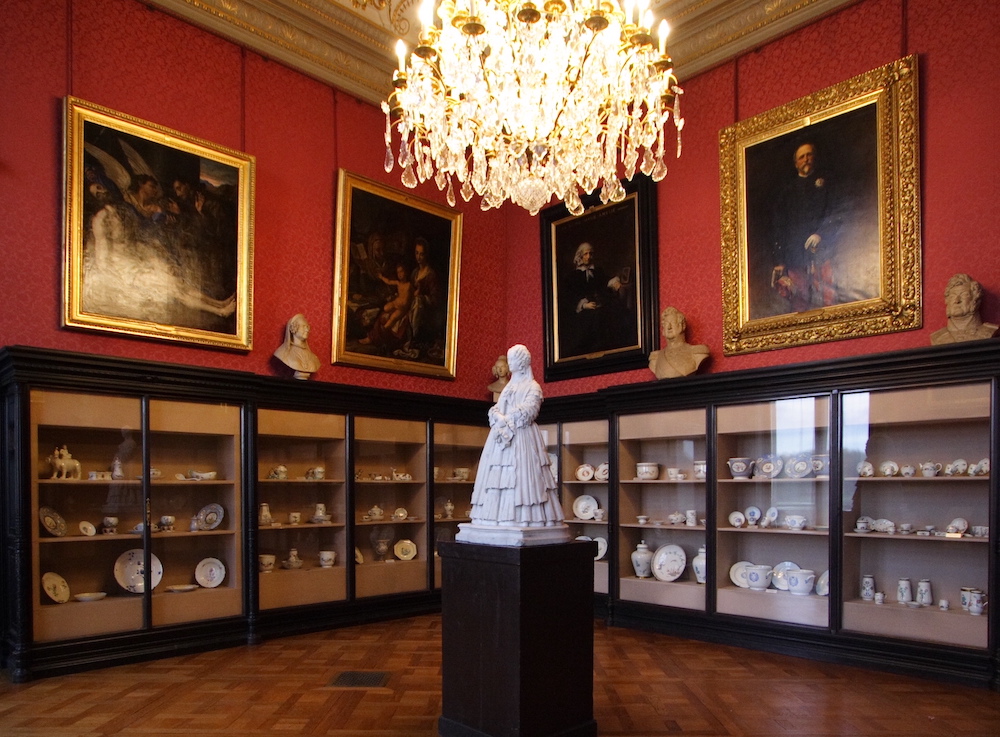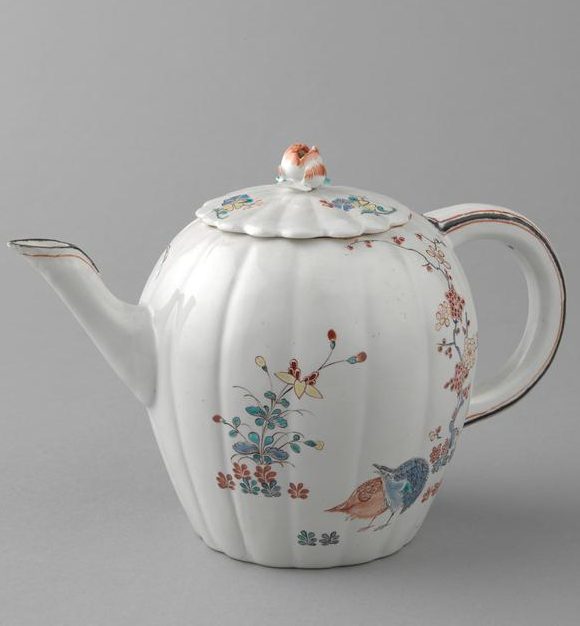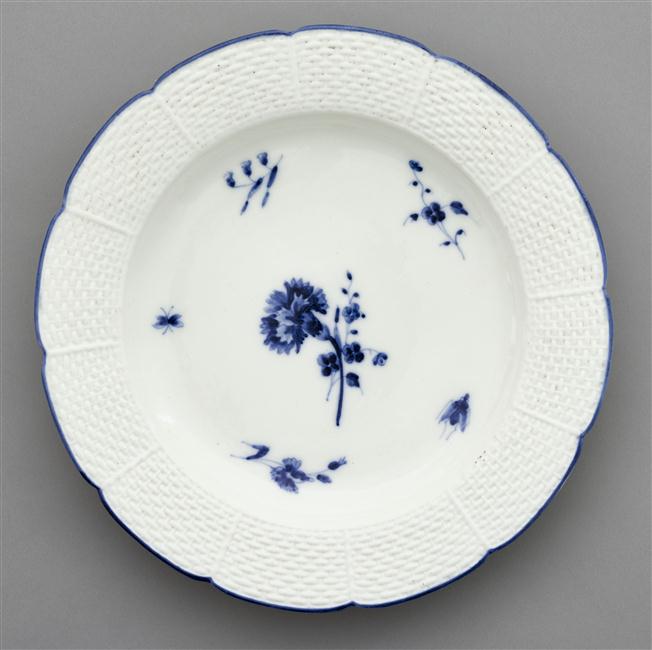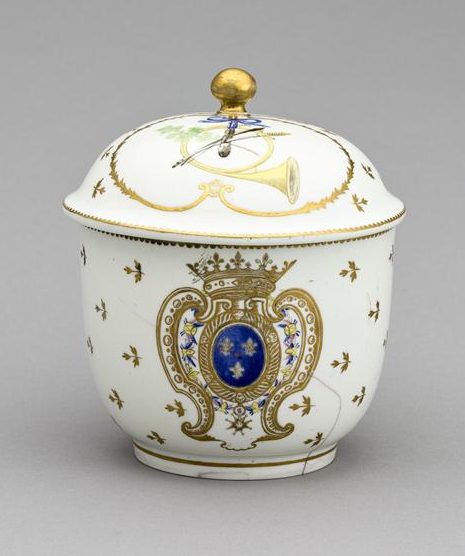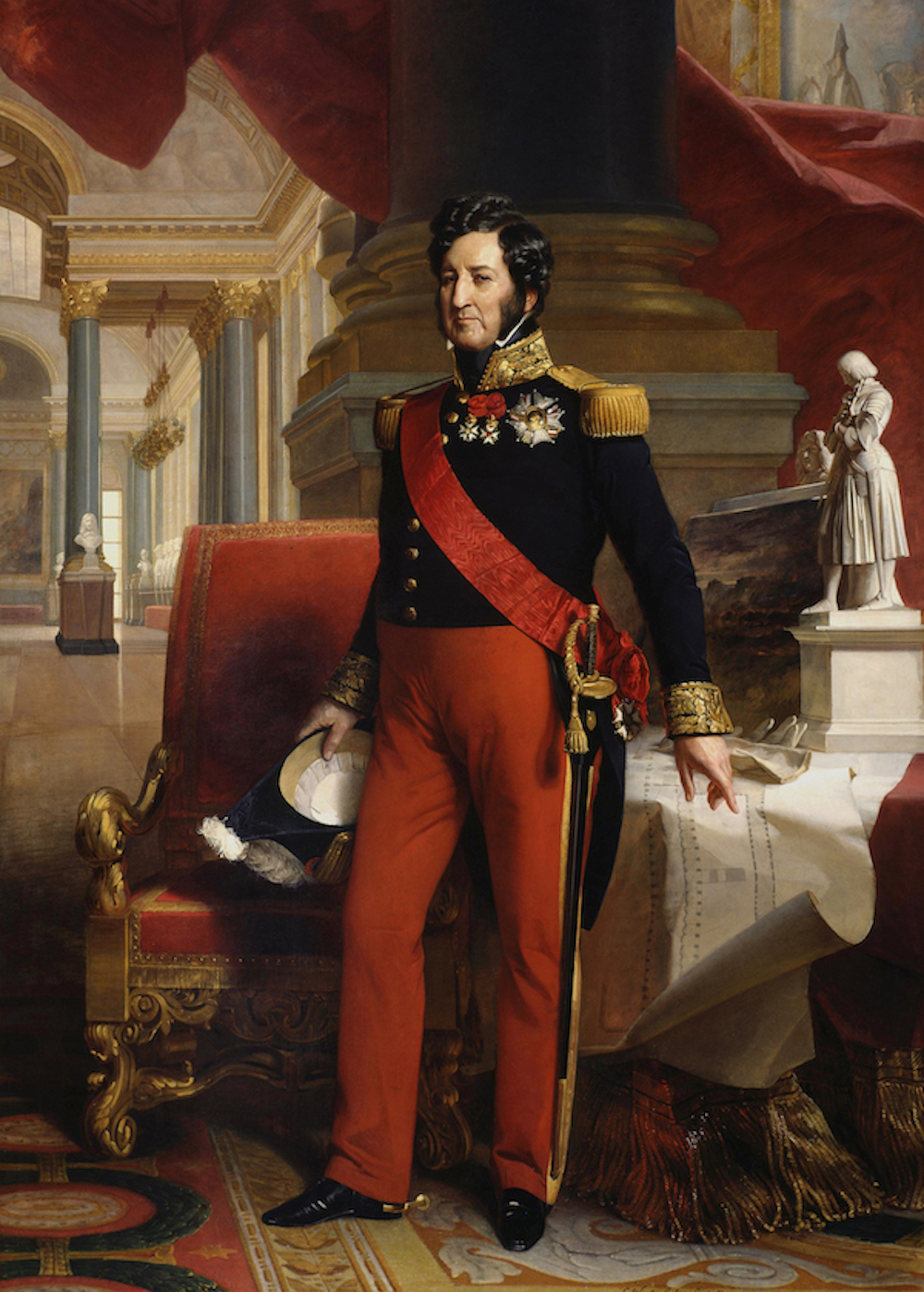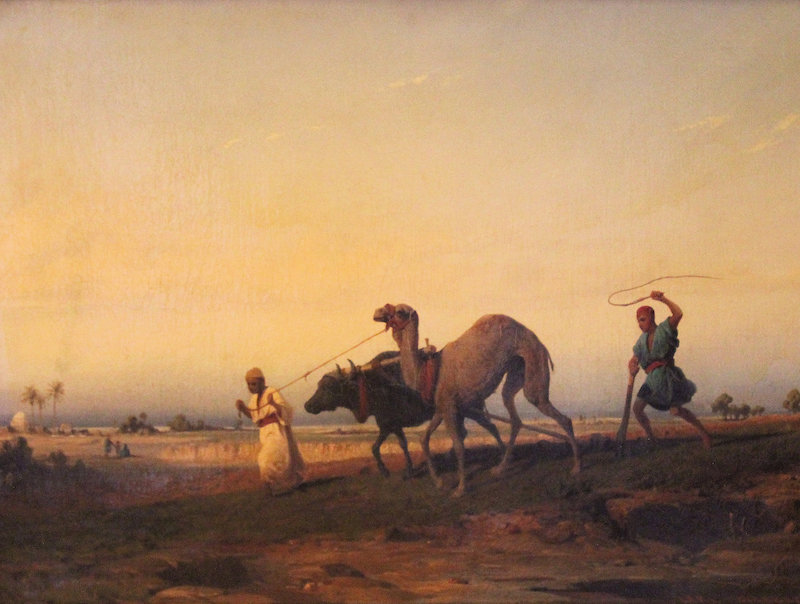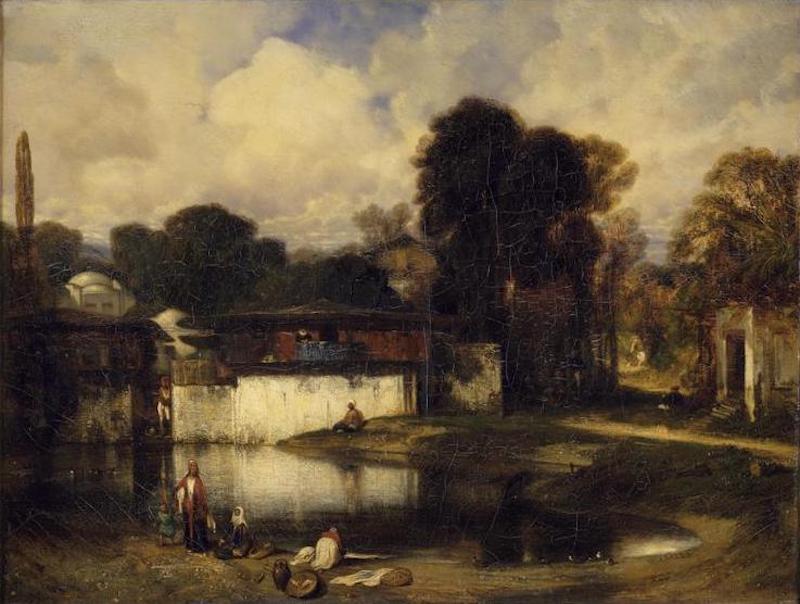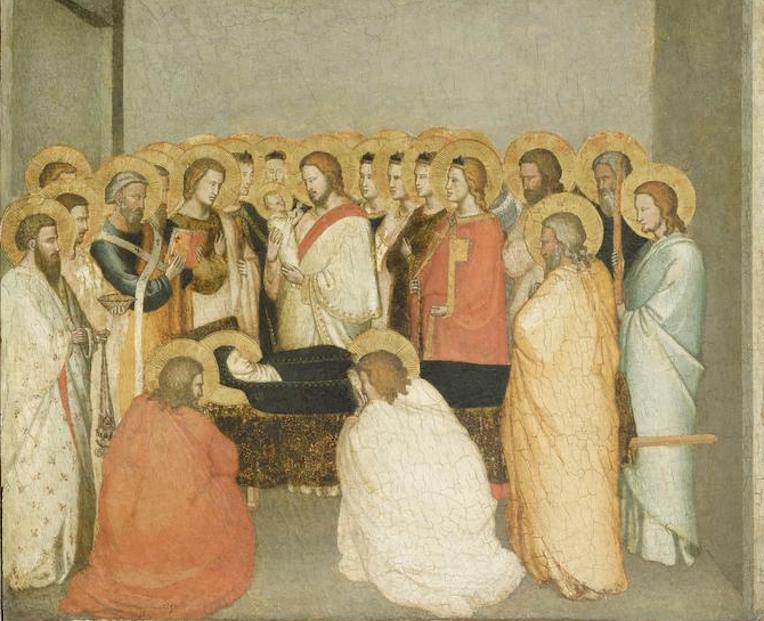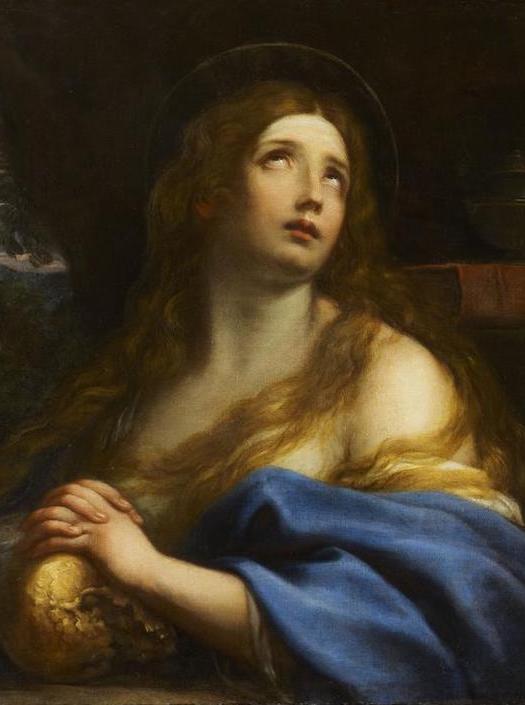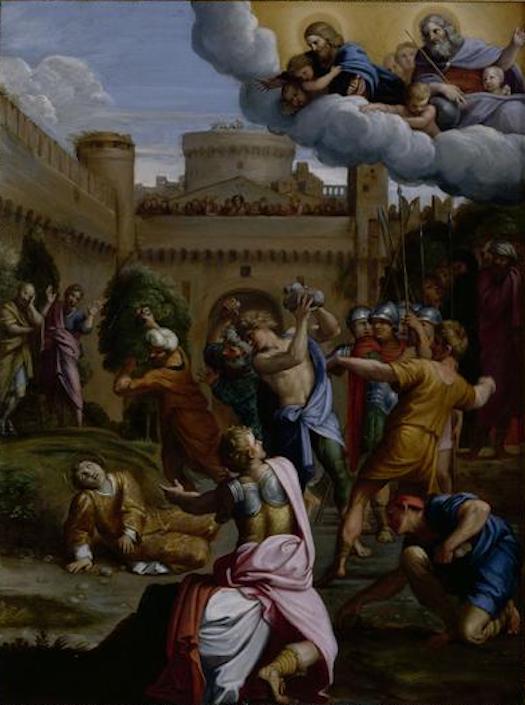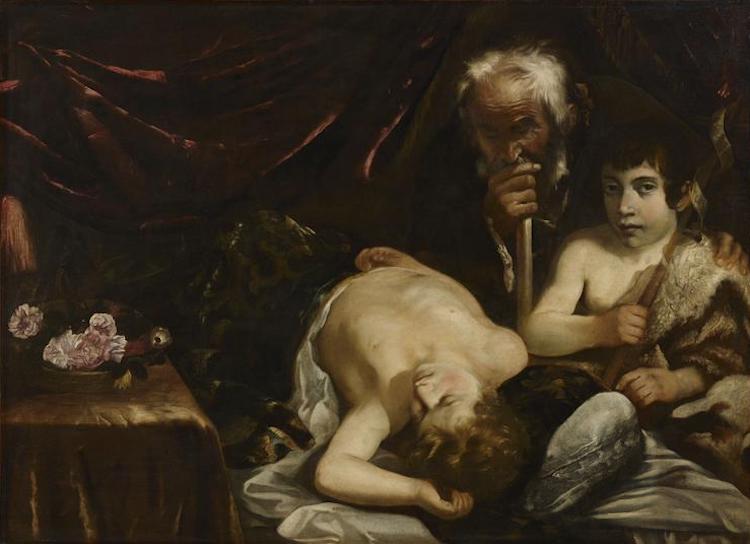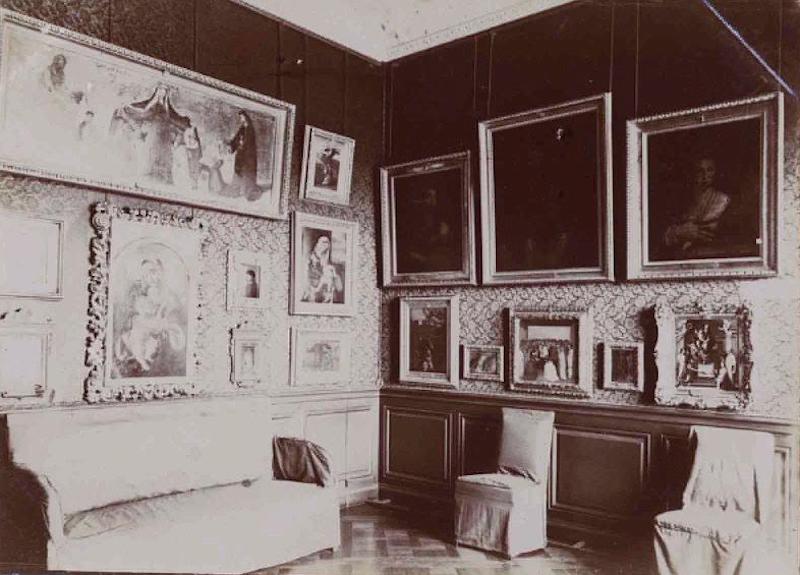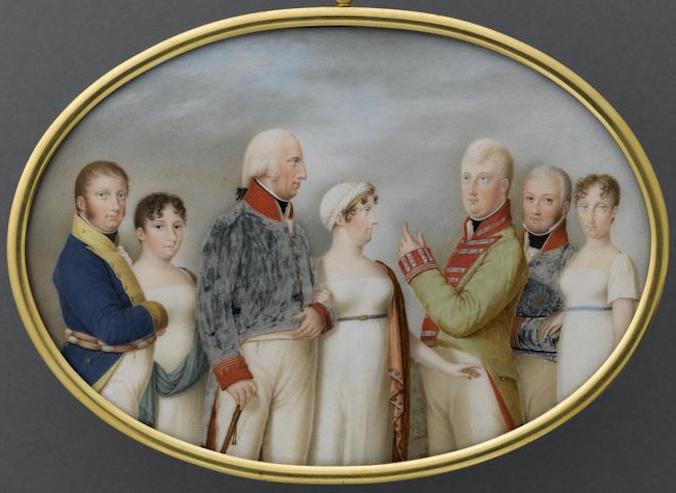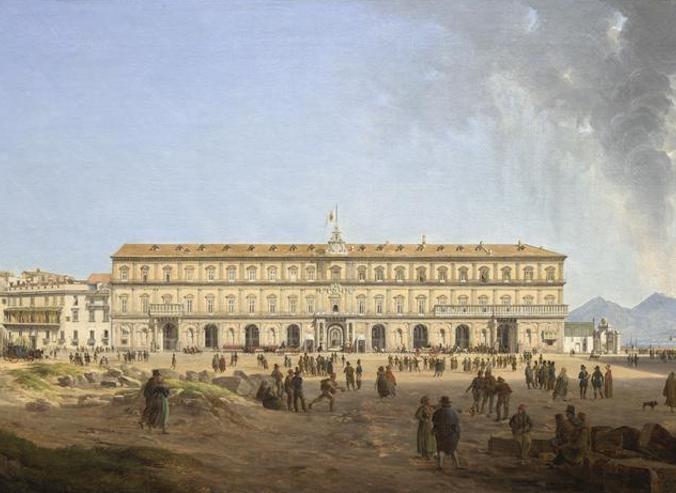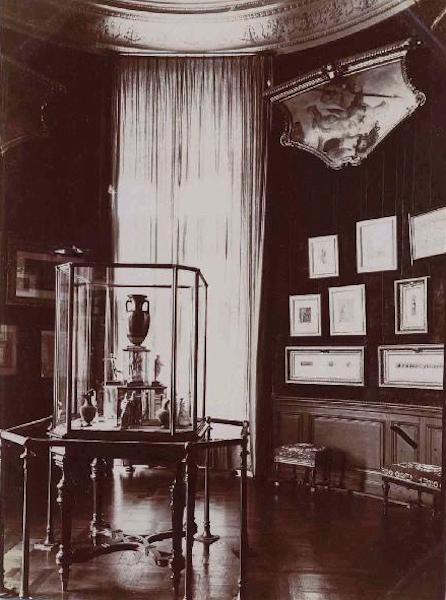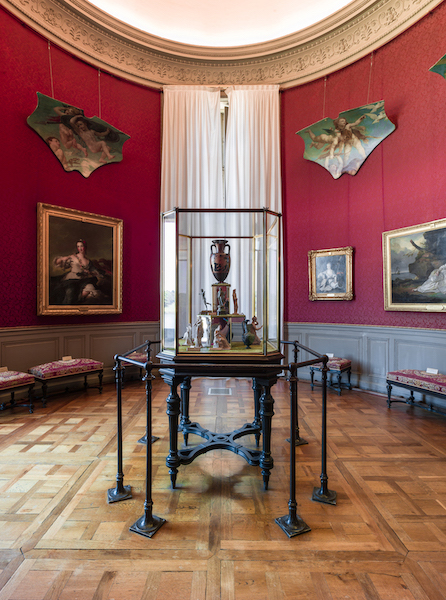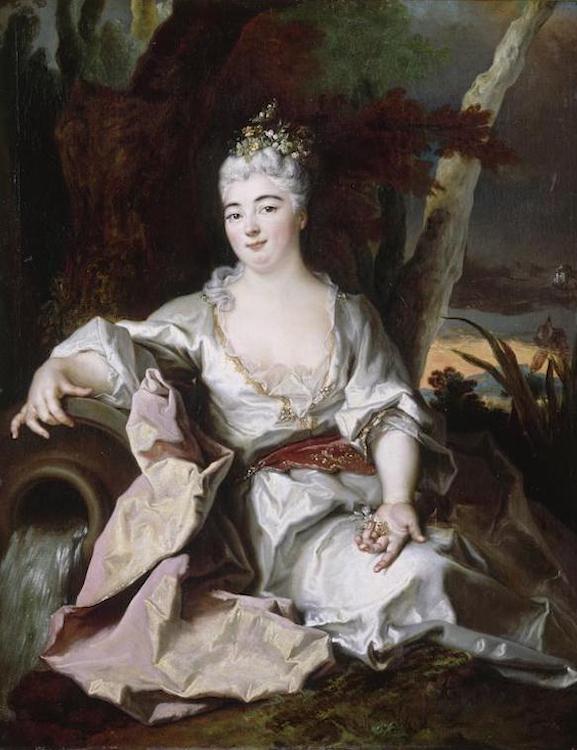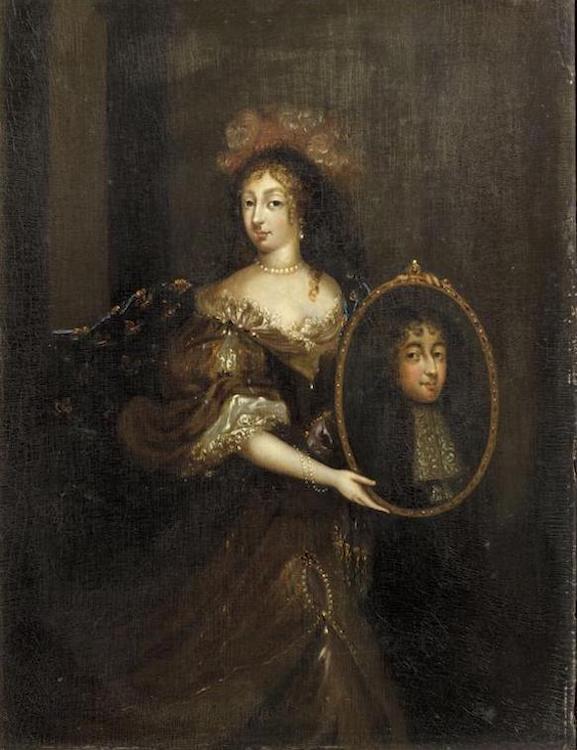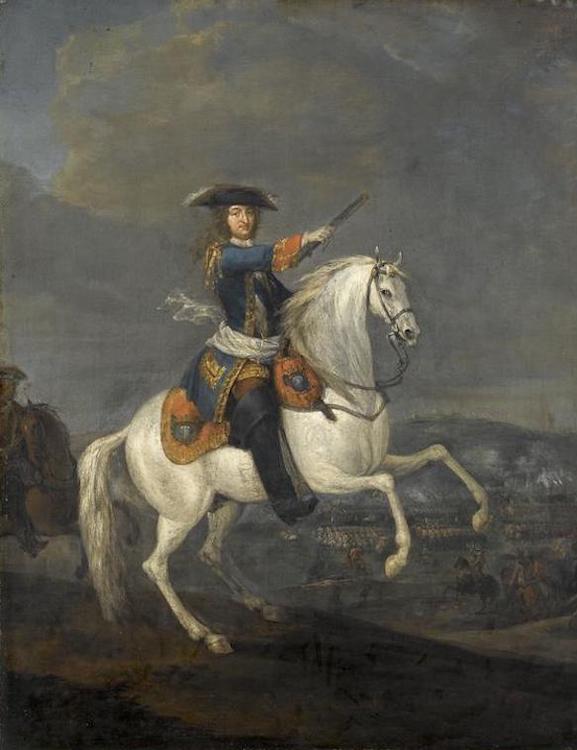➺ Skip to the Clouet Room
➺ Skip to the Caroline Room
➺ Skip to the Orléans Room / Porcelain Gallery
➺ Skip to the Isabelle Room
➺ Skip to the Giotto Room
➺ Skip to the Cabinet of Antiquities and Minerva Rotunda
➺ Make a contribution to the renovation project
Introduction
When the Duke d’Aumale inherited Chantilly in 1830, only the “Petit Château” built during the Renaissance remained intact, the larger castle dating from the 14th to the 18th centuries having been destroyed during the French Revolution.
Decades later, after amassing the finest private collection of Old Master paintings and drawings, furniture, and precious manuscripts, the Duke commissioned the architect Honoré Daumet to rebuild the “Grand Château.” Construction began in 1876 and finished, for the most part, in 1882. The new building, in the Neo-Renaissance style, was comprised of a chapel, living quarters, grand reception rooms, and paintings galleries.
The private apartments were intended for the Count of Paris, the Duke d’Aumale’s nephew and heir to the French throne, and his wife. After 1889, the Duke converted these rooms into additional galleries for his ever-growing art collection. Known as the “Logis,” they contain works by some of the most prominent French artists (Fra Angelico, Clouet, Watteau, Largillière, Delacroix, Géricault, Ingres…) as well as antiquities from Greece, Rome, Pompeii and Egypt.
These seven galleries are currently undergoing an important renovation program which includes the restoration of the paintings and their frames, creation of new wall hangings and trimmings to replicate the original fabrics from the Duke d’Aumale’s time, and improvements to the lighting. At the end of this major initiative, the Logis Galleries will once again be superb showcases for the Duke’s treasures.
Each week, a new video (in French with English subtitles) will be added here, featuring one of the rooms in the Logis wing. In every episode, Nicole Garnier or Mathieu Deldicque will share stories about the gallery, present highlights from the collection and discuss the upcoming renovation.
Credits: Henrik Frans de Cort, Chantilly, View from the Garden, 1781 © RMN-Grand Palais (domaine de Chantilly) / Thierry Ollivier; anonymous, Château de Chantilly, 1845 © RMN-Grand Palais (domaine de Chantilly) / René-Gabriel Ojeda; Adolphe Chappuis, Façade of the Château de Chantilly, 1880-1892 and anonymous, Château de Chantilly, View from the Garden, early 20th century © RMN-Grand Palais (domaine de Chantilly) / Michel Urtado; anonymous, Entrance to the Logis from the Courtyard, Salon d’Orléans and Minerva Rotunda, early 20th century © Réunion des musées nationaux-Grand Palais (domaine de Chantilly); Restauration de l’aile du logis © Gaspard Gosset – GGProduction.
Episode 1 – Clouet Room
The first room in the Logis presents 90 Renaissance portraits hung densely from floor to ceiling on three walls. The core of this extraordinary collection was acquired by the Duke d’Aumale, who had a great passion for this period. After all, Chantilly was the residence of the Constable Anne de Montmorency, who served all five Valois kings during the 16th century, before it passed to the Bourbon-Condé and finally to the Duke. This holding was enlarged in 1939 by a group of portraits from the Château d’Azay-le-Rideau donated by the Vicomtesse de Poncins-Biencourt.
The portraits in Chantilly’s collection – the largest such holding in the world – are for the most part attributed to Jean Clouet (who worked as painter and valet for Francis I as early as 1516), his son François Clouet (who inherited his father’s positions and served as official portraitist for Henri II, François II and Charles IX), and their workshop but also to their rivals and followers Corneille de Lyon, Augustin Quesnel, Germain Le Mannier, Jean Decourt, Marc Duval and others. Collectively, they carried on the art of French portraiture throughout the 16th century.
The Clouet Room is an illustrated social diary of the French Renaissance: kings and queens (and let’s not forget the mistresses), princes and princesses, and prominent members of the aristocracy, from the reign of Charles VII (1403 – 1461) to the court of Henri IV (1553 – 1610), can all be found here. Catherine de’ Medici and her children are represented several times; European monarchs like the Holy Roman Emperor Charles V, Mary Tudor and Anne Boleyn are also pictured. Such portraits were often used to negotiate marriages, offered as diplomatic gifts or simply kept as family mementos.
While most of the sitters are depicted in the same manner – half-length, three-quarter view against a neutral background – there is also an incredible amount of detail and attention given to the rendering of the faces, clothing, accessories and jewelry in each portrait. Some are even surprisingly whimsical like the painting of Henri II as a child holding a little dog.
This collection would be incredible on its own but Chantilly is also home to 366 portrait drawings by Jean and François Clouet and their workshop, the majority of which belonged to Catherine de’ Medici. A group of drawings representing court ladies were presented in the exhibition Clouet. Le miroir des dames in 2019.
Initially, in the 1870s, the Duke d’Aumale hung the paintings in the Psyche Gallery, along the wall facing 16th-century stained glass windows from the Château d’Ecouen. They were moved to their current location in the Logis Galleries in 1889 (because the Duke preferred to exhibit his newly acquired collection of Clouet drawings in the Psyche Gallery against expert advice about exposure to light!).
The current renovation work in the Clouet Room includes, first and foremost, the restoration and cleaning of the precious portraits and their frames. The wall hanging will be replaced by a new fabric in a deep, ruby-red color, identical to the one that originally hung in this room during the Duke d’Aumale’s time and new lighting will be installed. Finally, the display will be reconfigured to allow a better understanding and appreciation of the art of portraiture during the Renaissance.
Come back next week to explore the Caroline Room!
Credits: Le Cabinet des Clouet © Gaspard Gosset – GGProduction; Clouet Room © Friends of the Domaine de Chantilly; Clouet Room at the beginning of the 20th century © Réunion des musées nationaux-Grand Palais (domaine de Chantilly); François Clouet, Henri II as a Child and Elisabeth of Austria © RMN-Grand Palais (domaine de Chantilly) / René-Gabriel Ojeda; François Clouet, Anne de Montmorency © RMN-Grand Palais (domaine de Chantilly) / Michel Urtado; La vie au domaine – Episode 13 © Château de Chantilly.
Episode 2 – Caroline Room
This stunning room was named after Marie-Caroline de Bourbon-Siciles, Princess of Salerno and Duchess d’Aumale after her marriage to Henri d’Orléans on November 25, 1844 (the story of how the couple met will be told in the Cabinet of Antiquities!). A lovely portrait of the Duchess by Eugène Lami, who also decorated her private apartments, sits above the doorway.
The pictures on the entrance side wall and the left side wall have not changed since the Duke d’Aumale’s death in 1897. However, several paintings on the right side wall and the window side were rearranged especially in 1939 when a large group of Clouet portraits was donated by the Vicomtesse de Poncins-Biencourt and placed in the Clouet Room. At that time, some of the works hanging in the Clouet Room were moved to the Caroline Room to create a more coherent display.
Most of the paintings in this gallery are 17th- and 18th-century portraits including:
- Louis XVI by Joseph Siffred Duplessis, who created several copies of the King’s official portrait to be offered as diplomatic gifts to foreign monarchs and ambassadors, and his brothers the Count of Provence (future Louis XVIII) also by Duplessis and the Count d’Artois (future Charles X) by Henri-Pierre Danloux;
- members of the Bourbon-Condé family who owned Chantilly during this period such as Princess de Bourbon-Condé (daughter of Louis XIV and Madame de Montespan, married to Prince Louis III de Bourbon-Condé) by Pierre Gobert, Prince Louis-Joseph de Bourbon-Condé by an anonymous artist and Louis Henri Joseph de Bourbon-Condé (the last Prince de Condé who left Chantilly to the Duke d’Aumale) by Danloux;
- prominent figures like Henriette of France, Queen of England (daughter of Louis XIII and wife of Charles I) by Peter Lely, the Marquise de Pompadour (mistress of Louis XV) by François Drouais and the Duchess of Chartres (the Duke d’Aumale’s grandmother) by an anonymous artist.
The Caroline Room also contains works by some of the most famous artists of the 17th and 18th century: Pierre Mignard, Nicolas de Largillière, Hyacinthe Rigaud, François de Troy, Pierre Subleyras, Charles-André Van Loo, Juste d’Egmont, Jean-Baptiste Greuze and Jean-Antoine Watteau.
Like the other rooms in the Logis, this gallery needs a through renovation: many of the paintings will be cleaned and restored, the wall hanging will be replaced with a replica of the fabric from the late 19th century, and new lighting will be installed so that the beautiful portraits carefully acquired by the Duke d’Aumale can be appreciated in the best possible way.
See you next week in the Orléans Room a.k.a. the Porcelain Gallery!
Credits: La Salle Caroline © Gaspard Gosset – GGProduction; Caroline Room at the beginning of the 20th century © Réunion des musées nationaux-Grand Palais (domaine de Chantilly); Pierre Subleyras, Pope Benedict XIV and Sir Peter Lely, Henriette of France © RMN-Grand Palais (domaine de Chantilly) / René-Gabriel Ojeda; Nicolas de Largillière, Charles-Paris d’Orléans (?) © RMN-Grand Palais (domaine de Chantilly) / Thierry Ollivier.
Episode 3 – Orléans Room / Porcelain Gallery
This room was named in honor of the Duke d’Aumale’s family whose portraits are prominently displayed on the walls:
- his father, Duke d’Orleans (future Louis-Philippe) Asking for Hospitality from the Monks of Petit Saint-Bernard by Horace Vernet,
- his mother, Queen Marie-Amélie by Charles-François Jalabert,
- his aunt, Adélaïde d’Orléans by Marie-Amélie Cogniet,
- his sister-in-law, Duchess of Nemours (wife of Louis d’Orléans) as Diana, Goddess of the Hunt, whose portrait was specifically commissioned from Henri Decaisne for this room,
- his other sister-in-law, Princess of Joinville (wife of François d’Orléans) by Amédée Faure,
- and of course, Henri d’Orléans, Duke d’Aumale by Léon Bonnat.
Busts of the Orléans family members were added during the 20th century and include several works by the talented Princess Marie d’Orléans.
Mixed in with 19th-century family portraits are paintings from the Duke d’Aumale’s collection, many of which he acquired from his father-in-law, the Prince of Salerno. Among them are three important pieces of 17th-century Italian painting: An Angel Showing St. Francis of Assisi the Body of Christ Removed from the Cross and The Virgin and Child with Saint Elizabeth by Alessandro Allori, and The Holy Family with a Cat by Federico Barocci and his workshop.
Antonio Moro’s The Risen Christ between Saints Peter and Paul was originally acquired by the Prince Louis de Bourbon-Condé (1621-1686), who developed a great admiration for Flemish and Dutch schools during the years he spent in the Netherlands under the Habsburgs. Though he owned or commissioned works by Rubens, Van Dyck and Teniers, the painting by Moro was considered one of the greatest masterpieces in the Prince’s collection and in fact, it was the most expensive painting he ever purchased! Fortunately for the Duke d’Aumale, he inherited it along with the Château de Chantilly from his Godfather, the last Prince de Condé.
When the Duke d’Aumale decided to convert the Count of Paris’ apartments into art galleries, he chose the Orléans Room, the largest space in the Logis wing, as his Drawings Gallery. He installed custom-made cabinets along the walls to store his drawings in beautiful red albums and to facilitate their viewing. The Duke enjoyed showing off his impressive collection and often organized legendary lunch parties on Sundays when guests would dine in the Stag Gallery, then walk the short distance to the Orléans Room to admire the Duke’s drawings.
In the 1970s, the drawings were transferred to the Theater Library, the Duke’s former personal study located in a restricted area of the Château, for conservation and security reasons. However, the Duke’s tradition of sharing his collection has not been lost! A dedicated Gallery of Prints and Drawings was created in the Petit Château in 2017 and has since hosted an annual program of exhibitions on graphics arts.
As can be expected, the Château de Chantilly houses the largest collection of Chantilly porcelain in the world which continues to grow thanks to new acquisitions and donations. The Duke d’Aumale presented his porcelains in the Gem Gallery with small, precious artworks like miniature portraits. Once his drawing collection was moved to the Theater Library, the Orléans Room became the new Porcelain Gallery as we know it today.
The Chantilly Manufactory was founded in 1730 by Prince Louis-Henri de Bourbon-Condé (1692-1740). The ambitious Prince obtained the position of Prime Minister to Louis XV but fell out of the young King’s favor only 3 years later and was exiled to Chantilly. There, he channeled his energy into redecorating the Château in the flamboyant rococo style, building the Great Stables often referred to as a palace for horses, and creating the porcelain manufactory which was one of the earliest productions in France (it later inspired the Vincennes and Sèvres manufactories). Though the Chantilly manufactory ceased operating at the end of the century, it was highly appreciated by European aristocrats and merchants, and remains to this day one of the most beautiful examples of European porcelain productions.
The Orléans Room presents hundreds of historic pieces dating from the 18th century. Some bear the coat of arms of the Princes de Condé, others of the Orléans family. Most have the Chantilly manufactory’s characteristic mark of a hunting horn in blue or red on the bottom. While the majority of this collection is composed of tableware like cups, saucers, teapots, plates, coolers, bowls and platters – after all, the Princes de Condé entertained often and lavishly at Chantilly – it also includes decorative animal figurines as well as utilitarian objects like snuff boxes. Their décors also represent different periods of the production and vary from the early Kakiemon style imitating Asian porcelain to colorful floral designs or a simple but elegant blue and white which were popular during the second half of the century.
Chantilly’s current exhibition La Fabrique de l’extravagance. Les porcelaines de Meissen et de Chantilly, on view until August 28, tells the fascinating story of the Chantilly and Meissen productions and how they dominated decorative arts during the 18th century. It is a must-see show!
(in French with English subtitles)
(in French only)
The renovation program in the Orléans Room includes the restoration of the paintings, replacement of the wall hangings and the restoration of the chandelier. The Friends of the Domaine de Chantilly is delighted to sponsor this project and would like to thank all those who wish to participate in its efforts.
Don’t miss our tour of the Isabelle Room next week!
Credits: Le Salon d’Orléans © Gaspard Gosset – GGProduction; Marie-Amélie Cogniet, Adélaïde d’Orléans, 19th century, Antonio Moro, The Risen Christ between Saints Peter and Paul, ca. 1556, Chantilly Porcelain Manufactory, Teapot, ca. 1730-35 © RMN-Grand Palais (domaine de Chantilly) / René-Gabriel Ojeda; Orléans Room © Marc Walter, Chantilly le domaine des princes / Swan Editeur; Orléans Room at the end of the 19th century © musée Condé; Theater Library © Sophie Lloyd; Gem Gallery at the beginning of the 20th century © Réunion des musées nationaux-Grand Palais (domaine de Chantilly); Chantilly Porcelain Manufactory, Plate, 18th century and Sugar bowl, 1786 © RMN-Grand Palais (domaine de Chantilly) / Michel Urtado; En tête à tête avec un chef-d’oeuvre – Salon d’Orléans © Château de Chantilly; virtual visit of La Fabrique de l’extravagance. Porcelaines de Meissen et de Chantilly © Scribe Accroupi.
Episode 4 – Isabelle Room
This room was named in honor of Isabelle, daughter of Antoine d’Orléans, the Duke d’Aumale’s younger brother. In 1864, she married her first cousin Philippe, Count of Paris and son of Ferdinand-Philippe d’Orléans, the Duke d’Aumale’s oldest brother.
The Duke d’Aumale’s passion for collecting was influenced early on by his father. Louis-Philippe attempted to recover the extraordinary paintings that once belonged to his ancestor, Duke Philippe d’Orléans, Regent of France during Louis XV’s minority, in the Palais-Royal. Not only were his efforts hindered by political instability in France but they also proved too costly (the Duke d’Aumale would succeed to some measure decades later). The King thus turned his attention and patronage to contemporary French artists, many of whom received commissions for the new Museum of the History of France created at Versailles in 1837.
The inventory of Louis-Philippe’s possessions revealed hundreds of works in the Palais-Royal and the Tuileries Palace. When this collection was sold after the King’s death in 1850, the Duke d’Aumale acquired several paintings in his father’s memory and later, displayed them in the Isabelle Room:
- Louis-Léopold Boilly’s Interior of a Café in the Palais-Royal in 1820. The original, larger work was cut into pieces during the Revolution and only the lower central panel, at Chantilly, is known today.
- Eugène Delacroix’s The Guardhouse at Meknès
- Théodore Géricault’s Horse Leaving a Stable
- Théodore Gudin’s French Squadron before Le Tréport
- Karl Girardet’s Figures Ploughing in Africa
- Alexandre-Gabriel Decamps’s The Monkey and the Cat
The Isabelle Room presents 6 other Decamps all acquired in 1868 at the sale of the collection of the second Marquis de Maison, son of Louis-Philippe’s Minister of Foreign Affairs, then Minister of War. The purchase also included works by Prosper Marilhat, Pierre-Paul Prud’hon, Baron Gros as well as by Jean-Baptiste Greuze and Jean-Antoine Watteau, many of which are displayed throughout the Logis Galleries.
The Isabelle Room is particularly indicative of the Duke d’Aumale’s personal attachment to art as well as duty to his family. The rather eclectic choice of paintings reflects his memories from his childhood and youth at the Palais-Royal and the Tuileries Palace; his desire to honor his father’s collection and continue his patronage of contemporary artists; and his own appreciation for Orientalism shaped by the years he spent as Governor of Algeria.

Isabelle Room at the beginning of the 20th century 
Isabelle Room today
The renovation work, which includes new lighting, replacement of the faded wall hangings and the restoration of the paintings, will breathe new life into the Isabelle Room and help the visitors better understand the personal sentiments that guided the Duke’s collecting.
On the menu next week are Italian masterpieces in the Giotto Room!
Credits: La Salle Isabelle © Gaspard Gosset – GGProduction; John Mayall, Portrait of the Count and Countess of Paris, after 1863 © Réunion des musées nationaux-Grand Palais (domaine de Chantilly) / Michel Urtado; Franz Xavier Winterhalter, Louis-Philippe at the Entrance to the Gallery of Battles at Versailles, 1841 © Château de Versailles, Dist. RMN-Grand Palais / Gérard Blot; Louis-Léopold Boilly, Interior of a Café in the Palais-Royal in 1820 © RMN-Grand Palais (domaine de Chantilly) / Gérard Blot; Alexandre-Gabriel Decamps, Turkish Landscape, 19th century © RMN-Grand Palais (domaine de Chantilly) / Harry Bréjat; Isabelle Room at the beginning of the 20th century © Réunion des musées nationaux-Grand Palais (domaine de Chantilly).
Episode 5 – Giotto Room
The Giotto Room is dedicated to Italian paintings from the 14th to 17th centuries. Its name refers to The Dormition of the Virgin which was originally thought to be a work by the Early Renaissance master. It was later attributed to his student, Maso di Banco, who probably created this panel as part of an altarpiece around 1328-30, which would make it the oldest painting in Chantilly’s collection.
Five Angels Dancing was also attributed to Giotto but is given today to Giovanni di Paolo. It was most likely the lower part of a larger work possibly depicting The Virgin and Child or The Coronation of the Virgin, and was heavily restored during the 19th century.
About half of the paintings in this room, including The Dormition of the Virgin, came from Frédéric Reiset’s collection, purchased by the Duke d’Aumale in 1879. Reiset was a curator of paintings and drawings at the Louvre, then Director of French National Museums, and one of the first to study artists of the Trecento and Quattrocento at a time when 16th-century masters like Raphael were revered above all. While the Duke d’Aumale shared this notion, he clearly also recognized the importance of the earlier period and its place in the museum he was creating at Chantilly.
Other paintings in this room have prestigious provenances. Domenichino’s The Stoning of Saint Stephen belonged to Cardinal Mazarin, Prime Minister to Louis XIII and Louis XIV, then passed to the Regent Philippe d’Orléans – the famous Orléans Collection – but as a work of Annibale Carracci. After the French Revolution, the painting was sold several times in England and finally purchased by the Duke d’Aumale in 1860.
Several paintings belonged to Prince Leopold of Salerno, the Duke d’Aumale’s father-in-law and uncle, who had inherited a part of the fabulous collections of the kings of Naples and of the Farnese family through his father, King Ferdinand I of the Two Sicilies (grandson of Elizabeth Farnese). Prince Leopold’s collection included important works from the 16th and 17th centuries:
- Dosso Dossi’s Portrait of A Woman
- Guido Cagnacci’s Christ Asleep with Zacharias and Saint John the Baptist
- Francesco Albani’s Mary Magdalen in Prayer (initially attributed to Salvator Rosa)
- Salvator Rosa’s Christ Resurrected is one of 5 paintings commissioned by Carlo de Rossi for his chapel in the Church of Santa Maria di Montesano in Rome in 1677. The other 4 works can be seen in Chantilly’s Gallery of Paintings.
- Salvator Rosa’s Landscape with Fishermen and Landscape with a Tower (along with Christ Carrying the Cross in the Gallery of Paintings) were commissioned by Cardinal Paluzio Altieri for his palazzo in Rome.
The Giotto Room is crucial not only for the study of Italian art but also for the understanding of the history of collecting during the 19th century. In the upcoming restoration program, it will only require minor repairs and cleaning since it was renovated in 2003. At that time, Tassinari & Chatel reproduced the wall hangings that are identical to those that were originally selected by the Duke d’Aumale; the same fabric will be created for the rest of the Logis Galleries.
Next week, we will reveal the final video on the Minerva Rotunda and the Cabinet of Antiquities. See you then!
Credits: Le Cabinet du Giotto © Gaspard Gosset – GGProduction; Maso di Banco, The Dormition of the Virgin, ca. 1328-30 © RMN-Grand Palais (domaine de Chantilly) / Michel Urtado; Giovanni di Paolo, Five Angels Dancing, ca. 1430-35 and Domenichino, The Stoning of Saint Stephen, ca. 1605 © RMN-Grand Palais (domaine de Chantilly) / Harry Bréjat; Dosso Dossi, Portrait of A Woman, first half of the 16th century and Salvator Rosa, Landscape with Fishermen, ca. 1660-65 © RMN-Grand Palais (domaine de Chantilly) / René-Gabriel Ojeda; Francesco Albani, Mary Magdalen in Prayer, ca. 1620-30 © RMN-Grand Palais (domaine de Chantilly) / Thierry Ollivier; Guido Cagnacci, Christ Asleep with Zacharias and Saint John the Baptist, ca. 1630-40 © RMN-Grand Palais (domaine de Chantilly) / Martine Beck-Coppola; Giotto Room at the beginning of the 20th century © Réunion des musées nationaux-Grand Palais (domaine de Chantilly); Giotto Room © Marc Walter, Chantilly le domaine des princes / Swan Editeur.
Episode 6 – Cabinet of Antiquities and Minerva Rotunda
The Minerva Rotunda and Cabinet of Antiquities contain the Duke d’Aumale’s collection of Greek, Etruscan, Roman and Egyptian antiquities. This selection is modest but important for understanding the history of collecting during the 19th century. Almost every piece is accounted for and their acquisitions detailed in Chantilly’s excellent archives.
In November 1843, the young Duke d’Aumale traveled to Naples where he was received by his cousin, King Ferdinand II. This was no ordinary family reunion but rather a diplomatic mission to find a suitable wife for the 21-year-old prince. Though he was the 5th son of King Louis-Philippe, he had inherited the fabulous fortune of the last Duke of Bourbon including Chantilly – in fact, he was far wealthier than anyone else in his family! – and had just begun a promising military career. The Duke d’Aumale and his cousin, Princess Marie-Caroline of Bourbon-Two Sicilies, the only surviving daughter of Prince Leopold of Salerno, married a year later, on November 25, 1844, at the Royal Palace of Naples.
This trip was not only a matrimonial success, it also marked the start of the Duke d’Aumale’s collection of antiquities. As was customary during that time, King Ferdinand staged a pretend excavation at Pompeii for his cousin and offered him the findings. Since the excavation took place at a house known as Gabianianus’ inn, located next to a pharmacy in one of the more sophisticated neighborhoods of the city, most of the objects found were high quality tableware, cooking utensils and perfume bottles. The site was later renamed Casa del Duca di Aumale in honor of this royal visit.
In 1854, the Duke d’Aumale purchased the collection of his father-in-law, the Prince of Salerno, which included an incredible selection of Italian paintings as well as Roman antiquities. Several statues are presented in the Cabinet of Antiquities while the rest of the collection is dispersed throughout the Château.
The remaining objects were acquired from various sales. For example, in 1865, the Duke purchased 2 bronze statues representing Jupiter and Minerva and an Attic red-figure vase from the Count of Pourtalès. As was usually the case, the Duke’s colossal wealth allowed him to outbid the British Museum for the Minerva, which later gave its name to the gallery where it is exhibited. He also bested the Louvre for the vase found at Nola, near Naples. Baron Henri de Triqueti, who often served as the Duke’s agent in France, wrote to the prince: “You own the most perfect Greek vase and you are the envy of every museum.”
A number of other pieces were acquired over several decades like the group of Greek Tanagra figurines (including a few fakes, which was not uncommon at the time), additional statues discovered in Italy and 2 papyri from the Book of the Dead. The Cabinet of Antiquities and the Minerva Rotunda are the perfect example of a collection created by an educated and savvy collector during the 19th century.
Finally, several exquisite portraits of members of the Orléans family can be found in the Minerva Rotunda:
- Nicolas de Largillière, Princess Elisabeth Charlotte, Duchess d’Orléans
- Théodore Netscher, Henrietta of England, Duchess d’Orléans, with a Portrait of the Duke d’Orléans
- After Pierre Mignard, Henrietta of England, Duchess d’Orléans
- Anonymous, Philippe d’Orléans, Regent of France
- Jean-Marc Nattier, Louis-Henriette de Bourbon-Conti, Duchess d’Orléans, as the Goddess Hebe
- Joseph-Siffrein Duplessis, The Duchess of Chartres with « Le Saint-Esprit » Taking the Duke of Chartres to the Battle of Ushant
- Carle Vernet, The Duke d’Orléans and His Son, the Duke of Chartres, Hunting
- Ary Scheffer, King Louis-Philippe
The renovation program in the Minerva Rotunda and the Cabinet of Antiquities, like in the rest of the Logis Wing, includes the restoration of the artworks (paintings, frames and statues), replacement of the wall hangings and trimmings, and improvements to the lighting.
Credits: La Rotonde de la Minerve et le Cabinet des Antiques © Gaspard Gosset – GGProduction; Joseph Rebell, Royal Palace of Naples, 1814 © RMN-Grand Palais (domaine de Chantilly) / Michel Urtado; Anonymous, Royal Family of Naples and the Duke d’Orléans (future Louis-Philippe), Italy, Pitcher and Venus Anadyomene, Théodore Netscher,Henrietta of England, Duchess d’Orléans, with a Portrait of the Duke d’Orléans and Anonymous, Philippe d’Orléans, Regent of France © RMN-Grand Palais (domaine de Chantilly) / René-Gabriel Ojeda; Cabinet of Antiquities and Minerva Rotunda at the beginning of the 20th century © Réunion des musées nationaux-Grand Palais (domaine de Chantilly); Minerva Rotunda © Adrien Michel; Nicolas de Largillière, Princess Elisabeth Charlotte, Duchess d’Orléans© RMN-Grand Palais (domaine de Chantilly) / Harry Bréjat.
The Friends of the Domaine de Chantilly is raising funds to help support the restoration of the Logis Galleries and in particular the Orléans Room (Chantilly Porcelain Gallery). If you would like to make a contribution, please see below or contact us.
Tax deductions
Contributions are fully tax-deductible within the limits prescribed by U.S. law.Payment by check
Please complete this donation form and mail it with your check (payable to "Friends of the Domaine de Chantilly") to: Friends of the Domaine de Chantilly 1350 Avenue of the Americas, Fl. 2 New York, NY 10019Payment by credit card or PayPal
Please complete the form below."*" indicates required fields
